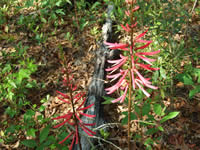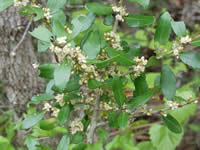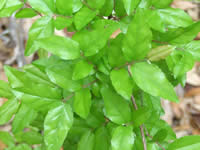USDA Forest Service Celebrating Wildflowers
|
|
|
Southern Region Viewing AreaLOCATION and PHOTOS
Sewee Shell Mound Interpretive TrailForest: Francis Marion National Forest District: Francis Marion Ranger District Description: The Sewee shell mound interpretive trail is a self-guided loop which will lead you to a 4,000-year old shell ring, an 800-year old clamshell mound, and through three plant communities. Sewee shell mound is one of the oldest, most northern shell rings in the United States. Rising 3-10 feet above the neighboring marshland, and about 225 feet across, the ring was built 4,000 years ago by the fishing and hunting Indians of Thom's Creek. The shell mound, or midden, was actually a mound of oyster shells once used by Prehistoric Native Americans in their daily life and for ceremonial purposes. Over time, the shells have broken down into a ring of rich soil, providing a special combination of native plants, and breathtaking views of salt marsh, tidal creeks, and the Atlantic Intracoastal Waterway. Wildflower viewing: Travel this trail and notice the plant life around you among three primary plant communities: the maritime forest, the shell-influenced maritime forest, and the salt marsh flats. Maritime forests or "forests of the sea", are woodland areas shaped by the wind, the salt, and changing levels associated with major storms and hurricanes. The most common species you will see in the maritime forest are the live oak (Quercus virginiana) with its long spreading branches and yaupon (Ilex vomitoria), an evergreen shrub in the holly family whose leaves were used for spiritual purification. As you approach the shell mound, you will see calcium-dependent plants, including red buckeye (Asclepias pavia), wild spotted geranium (Geranium maculatum), and the striking red flowers and fruits of coralbean (Erythrina herbacea). Once on the mound or ring itself, look for the rare shell-mound buckthorn (Sageretia minutifolia) and toothache tree (Zanthoxylum clava-herculis). In fall, look for the colorful seal lavender (Limonium carolinianum) and sea ox-eye (Borrichia frutescens). Safety First: Before you begin, make sure to have bug spray for your visit, particularly from April through November, when mosquitoes from the salt marsh are particularly severe. Stay on the trail and boardwalk to avoid poison ivy and to protect the fragile natural and cultural resources. Be prepared for hot and humid weather. Bring plenty of water and wear sunscreen and a hat. Directions: From Charleston, take US Highway 17 north to Doar Road North (SC Route 432-S). Turn right and go 2.5 miles to Salt Pond Road. Turn right on FS Road 243 and go ½ mile to trailhead. Ownership and Management: U.S. Forest Service, Francis Marion and Sumter National Forests, Francis Marion Ranger District. Nearest Town: Awendaw, South Carolina. |
|
| NOTE: PDF format links require the Adobe Acrobat Reader to view. | |
| top | Disclaimers | FOIA | Privacy Policy | Quality of Information | Photo Credits & Use |
Location: http://www.fs.fed.us/wildflowers/regions/southern/SeweeShellMound/index.shtml
Last modified: Tuesday, 24-Jun-2008 21:57:36 EDT



